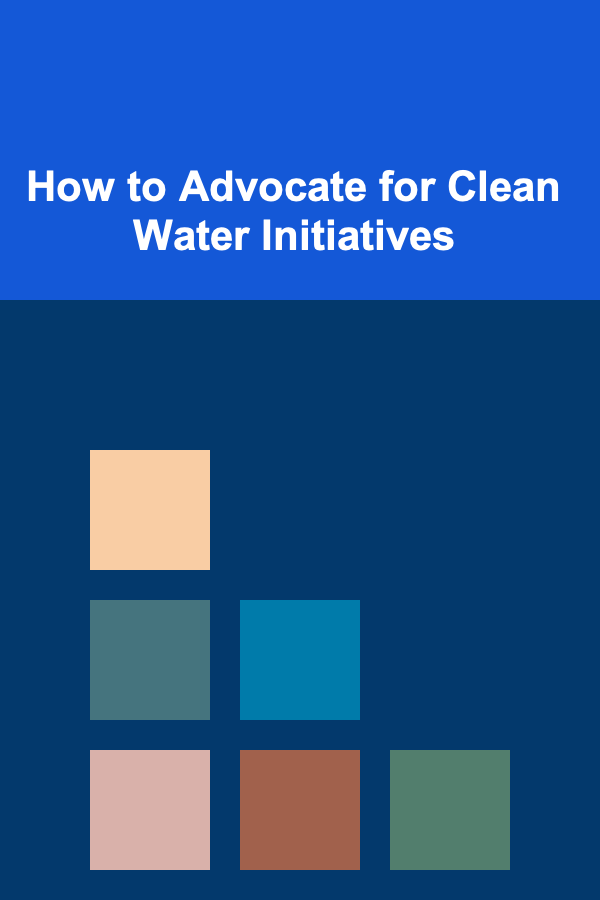
How to Advocate for Clean Water Initiatives
ebook include PDF & Audio bundle (Micro Guide)
$12.99$7.99
Limited Time Offer! Order within the next:

Clean water is a fundamental human right, essential for health, sanitation, and overall well-being. However, despite its vital importance, access to clean water remains a challenge for millions around the world. Whether due to pollution, climate change, or inadequate infrastructure, many communities face difficulties in obtaining safe drinking water. Advocacy for clean water initiatives is a powerful way to drive change, raise awareness, and mobilize efforts toward ensuring that everyone has access to this basic necessity.
In this article, we will explore how to effectively advocate for clean water initiatives, from understanding the global water crisis to engaging communities, collaborating with organizations, and influencing policy. We will also discuss practical strategies for raising awareness, building support, and achieving sustainable change.
Understanding the Global Water Crisis
Before diving into advocacy efforts, it is important to have a clear understanding of the global water crisis. Clean water scarcity affects over 2 billion people worldwide, with many living in regions where access to safe drinking water is limited or non-existent. The situation is exacerbated by factors such as pollution, poor infrastructure, population growth, and climate change.
The Scale of the Problem
- Pollution: Industrial waste, agricultural runoff, and improper waste disposal have led to the contamination of freshwater sources. Chemicals, heavy metals, and pathogens make water unsafe for consumption.
- Climate Change: Rising temperatures and changing rainfall patterns contribute to water shortages. Droughts and floods, both intensified by climate change, disrupt water supply and quality.
- Inadequate Infrastructure: In many developing countries, the lack of proper sanitation and water delivery systems makes it difficult for people to access clean water. Lack of investment in water infrastructure leads to insufficient storage, filtration, and distribution systems.
- Water Inequity: Marginalized communities---especially those in rural areas, informal settlements, or underdeveloped regions---often face the brunt of water scarcity. Women and children, who are traditionally responsible for water collection, are disproportionately affected.
The challenge of providing clean water to all is both a technical and ethical issue, demanding collective efforts from governments, organizations, and individuals. To effectively advocate for change, it is crucial to understand the complexity and urgency of the situation.
Why Advocacy for Clean Water is Crucial
Advocacy plays a pivotal role in raising awareness about the global water crisis and pushing for systemic change. By advocating for clean water initiatives, individuals and organizations can address not only the immediate needs of affected communities but also contribute to long-term solutions that promote sustainability and resilience.
Benefits of Advocacy
- Raising Awareness: Advocacy helps to draw attention to the urgency of the water crisis and mobilize individuals, organizations, and governments to take action. Increased awareness can lead to greater public support and political will.
- Shaping Policy: Effective advocacy can influence policy decisions at local, national, and international levels. This can result in stronger regulations, increased funding for water projects, and commitments to improve water access.
- Building Coalitions: By advocating for clean water, individuals and groups can unite across borders and sectors, creating coalitions that share resources, knowledge, and strategies for effective action.
- Empowering Communities: Advocacy empowers communities to take charge of their own water needs by providing education, resources, and training on sustainable water management and conservation.
Key Strategies for Advocating for Clean Water Initiatives
1. Educate Yourself and Others
The first step in advocating for clean water is understanding the issues and being able to communicate them effectively. This requires research, staying updated on the latest developments, and being informed about the local and global challenges people face in accessing clean water.
- Understand the Causes and Consequences: Be knowledgeable about the underlying causes of water scarcity and contamination, including political, economic, and environmental factors.
- Use Facts and Data: Support your advocacy efforts with concrete data and facts. Statistics on water access, contamination rates, and health impacts will make your case more compelling.
- Share Personal Stories: Stories from individuals and communities directly affected by the water crisis are powerful tools for raising awareness and humanizing the issue. Personal testimonies create empathy and motivate action.
- Dispel Myths: There are many misconceptions about water issues, especially in developed countries where clean water is readily available. Counter these misconceptions by emphasizing the global nature of the crisis.
2. Collaborate with Other Advocacy Groups
Building alliances with like-minded organizations can amplify your advocacy efforts. Many organizations, both local and international, are already working on clean water initiatives, and partnering with them can increase your impact.
- Join Existing Campaigns: Instead of starting from scratch, consider aligning your efforts with established campaigns. Organizations like WaterAid, UNICEF, and the World Health Organization have global programs that work towards improving water access and sanitation.
- Local Partnerships: Collaborate with local communities, NGOs, and grassroots organizations to address the specific water challenges faced by the population. Local organizations are often more attuned to the needs and concerns of the community.
- Share Resources: By collaborating, you can pool resources, knowledge, and networks to create more effective advocacy strategies.
3. Engage with Policy Makers
One of the most effective ways to advocate for clean water initiatives is by engaging with policymakers. Government action is crucial for creating and implementing policies that can ensure equitable access to clean water for all.
- Lobbying: Reach out to government representatives at local, national, and international levels to push for policies that prioritize clean water. Present compelling data, personal stories, and the economic and social benefits of investing in clean water.
- Public Campaigns: Organize petitions, protests, or social media campaigns that demand clean water initiatives. Public pressure on policymakers can be a powerful tool for bringing about change.
- Provide Solutions: When advocating for clean water, it is important to offer solutions. This may include proposing specific policies, funding mechanisms, or technologies that can address water scarcity and contamination.
4. Leverage Social Media and Technology
Social media and technology provide a unique platform for advocacy. Platforms like Twitter, Facebook, Instagram, and TikTok allow individuals and organizations to reach a global audience quickly and efficiently.
- Create Viral Campaigns: Share powerful images, videos, and facts about the water crisis to engage your audience. Use hashtags and trends to amplify your message.
- Host Webinars and Live Streams: Organize online events where experts can discuss the water crisis and its solutions. These events can serve as both educational tools and platforms for rallying support.
- Crowdfunding: Use crowdfunding platforms to raise money for clean water projects. This can help finance local water initiatives, such as drilling wells, building sanitation facilities, or providing water filtration systems.
- Mobilize Youth: Younger generations are highly engaged on social media and more likely to be passionate about global issues. Encourage young people to get involved, share their perspectives, and advocate for clean water solutions.
5. Promote Sustainable Water Practices
Advocacy is not just about addressing immediate water needs but also about ensuring that communities can sustainably manage their water resources in the long term.
- Rainwater Harvesting: Encourage the practice of rainwater harvesting as a way to supplement local water supplies and reduce dependence on traditional sources.
- Water Conservation: Advocate for water-saving techniques such as efficient irrigation systems, low-flow toilets, and responsible water usage in households and industries.
- Education and Training: Provide communities with the knowledge and tools to manage their own water resources. This may include training in sustainable agriculture, water filtration methods, and hygiene practices.
- Supporting Green Technologies: Advocate for the adoption of green technologies that improve water access and quality, such as solar-powered water pumps, eco-friendly sanitation systems, and natural filtration techniques.
6. Fundraising and Resource Mobilization
Funding is often a major barrier to implementing clean water initiatives. As an advocate, it is important to explore various ways to raise funds and mobilize resources for water-related projects.
- Organize Fundraising Events: Host events such as charity runs, auctions, or benefit concerts to raise money for clean water initiatives.
- Corporate Sponsorships: Approach corporations to sponsor water projects as part of their corporate social responsibility efforts. Many businesses are looking for opportunities to contribute to global causes.
- Grants and Donors: Research available grants from governments, international organizations, and private donors that can fund clean water projects.
7. Monitor and Evaluate Impact
Effective advocacy includes not only promoting initiatives but also monitoring and evaluating their impact. Ensuring that projects are effective and that resources are being used efficiently is crucial to long-term success.
- Track Progress: Use data and feedback from communities to assess the progress of clean water initiatives. This will help identify areas that need improvement and ensure that resources are being used effectively.
- Public Reporting: Share the outcomes of your advocacy efforts with your audience to demonstrate the tangible results of their support. Transparency builds trust and encourages further engagement.
Conclusion
Advocating for clean water initiatives is a crucial endeavor in ensuring that everyone, everywhere, has access to safe and sustainable water sources. By educating yourself and others, collaborating with organizations, engaging policymakers, and leveraging technology, you can help bring about meaningful change. Clean water is not just a necessity for survival; it is a foundation for health, dignity, and prosperity. Through advocacy, we can help secure a better future for all, one drop at a time.

How To Analyze the Director's Use of Cameos
Read More
How to Use Digital Product Creation to Make Money
Read More
Why Utilizing Vertical Gardens Can Organize Outdoor Spaces
Read More
How to Paint Abstract Art with Palette Knives
Read More
How to Create a Contingency Plan for Your Advertising Campaigns
Read More
10 Tips for Wildlife Photography with a Smartphone
Read MoreOther Products

How To Analyze the Director's Use of Cameos
Read More
How to Use Digital Product Creation to Make Money
Read More
Why Utilizing Vertical Gardens Can Organize Outdoor Spaces
Read More
How to Paint Abstract Art with Palette Knives
Read More
How to Create a Contingency Plan for Your Advertising Campaigns
Read More